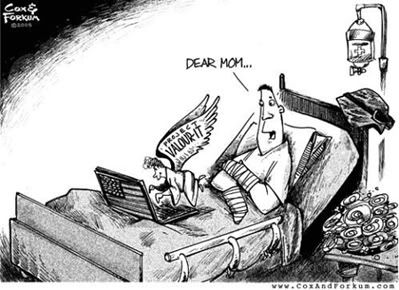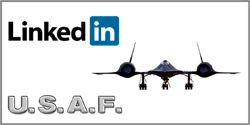Sleeping Giant? You've Got Zeus Dancin' on Your Head!
When will they ever learn? You taunt us with your words, we glare and take it all in. You poke us on the shoulder, we muster our control and size up the enemy. You poke us in the eye, we turn to collect our mettle - and then we take control. You strike any of us down, we bring it on, full force, with confidence, alacrity, and accuracy that could put an atomic clock to shame!
As has been a constant thread in my previous postings, science and technology have propelled the United States Military into uncharted territory: less manpower required to prosecute a war, with surgical precision, at greater distances, with excessively marginal casualty numbers. Strategy, tactics, mixed forces, and combined mission goals are taking the fight to foreign soil like no one has ever seen before.
In the latest Air and Space Power Journal (Winter 2005, Volume XIX, No. 4) I was pleasantly surprised by the story entitled, "The War Fighter's Need for Science and Technology". The analysis provided by the authors Dr. J. Douglas Beason, Colonel, USAF, Retired* and Dr. Mark Lewis was outstanding. It's amazing what one can learn in a few short moments of reading.
I knew in my heart back in 1984 that the future of the United States Air Force was beyond what anyone could dream. I was asked to assist our brothers down the flightline, the 7th SOS, in installing new technology on a few birds. When I was told how the accuracy of this new technology would dawn a new era in warfare, I believed it but wondered how we'd make it happen. Our systems were clunky, big, heavy, and, well, finicky! As the scientists of the 50's through the 80's would soon prove, the giant may have looked asleep, but he was thinking the whole time.
This opening paragraph says it all:
"Since the beginning of World War II, we have seen the introduction of radar, precision-guided weapons, atomic bombs, ballistic missiles, transistors, semiconductors, computers, jet aircraft, stealth technology, satellites, cell phones, lasers, the global positioning system (GPS), and so forth. The list of scientific and technical applications in warfare is staggering. Each of these technologies has had a profound impact on the way we fight and, equally importantly, on the way we keep our war fighters out of harm's way. Furthermore, the pace of inserting winning technology is increasing. In the millennia since humankind has kept records, estimates indicate that the world has seen a doubling -- a 100 percent growth -- in knowledge from the dawn of time until the 1950s. That knowledge, which has doubled several times since then, has spilled over to the war fighter. In many cases, it has actually been driven by his or her needs."What a mouthful!
For those of you that remember, warfare was tough, dirty, deadly, and expansive. The campaign theater required multiple managers to prosecute any war. Varying levels of strategy managers and tactical leaders required staggering numbers of combatants to take the field. As Dr. Beason writes, the number density of combatants (the number per square kilometer) has decreased over the years due to:
"... the introduction of state-of-the-art weapons. One may understand the increase in firepower by considering the way technology has enabled fewer war fighters to levy more damage at a longer distance: the range of a spear was extended by the bow and arrow, whose range was extended by the bullet, whose range was extended by the artillery shell, whose range was extended even farther by missile technology. New technologies such as hypersonic missiles, which can cover hundreds of miles in a matter of minutes, or directed-energy weapons, which can engage the enemy at the speed of light, allow us to extend a weapon's range beyond national borders or even around the world, reducing manpower density on the battlefield even further."The numbers of combatants that take the field looks like this:
 Figure 1. Manpower density on the battlefield
Figure 1. Manpower density on the battlefield(From data in Kenneth L. Adelman and Norman R. Augustine, The Defense Revolution: Intelligent Downsizing of America’s Military [San Francisco: Institute for Contemporary Studies Press, 1990], 55; and from Cable News Network.)
Did you see it?! Just take WWII and the Gulf War. Per square kilometer for WWII, we needed 2,200 combatants to be in the fight, and in the Gulf War only 0.5 combatants per square kilometer were required!
AND WE DID NOT HAVE UAVs AND UCAVs YET!
And, this is only the first two paragraphs! I mean, his next point is the effectiveness of the military. I'll really condense what he provided into a short list:
- Bullets (1500AD) have a military effectiveness of 102 or 100 times greater than arrows (1000AD)
- ICBMs (1970AD) are 108 or 100 million times more effective than artillery (1900AD)
- Lasers (2020AD) as 10 billion times more effective than the same artillery (1900AD)
 Figure 2. Military effectiveness through the years
Figure 2. Military effectiveness through the years(From data in Simon P. Worden, SDI and the Alternatives [Washington, DC: National Defense University Press, 1991].)
"Although military tactics and strategy have played a role in increasing the effectiveness of these weapons, advances in military effectiveness stem chiefly from the exploitation of science and technology..."
"... the dramatic increase in such effectiveness on a logarithmic scale; that is, the vertical axis of the figure shows exponential powers of 10, so the maximum value of 25 is not a simple factor of five greater than 20 but 105 — 100,000 times greater."
He said 100,000 times!
Here, some hard numbers:
"To hit a 200,000 square foot German factory in World War II with a 96 percent chance of success required a squadron of 108 B-17 bombers (carrying 1,080 aircrew members and 648 bombs) and approximately 100 single-seat escort fighters, bringing the total force to nearly 1,200 human lives. Typically, 15 of the bombers and their 150 men would not make it back home."
"Today we could perform the same mission either with a single F-117 stealth fighter dropping two precision-guided bombs or with one cruise missile. Furthermore, to date only one F-117 has ever been shot down in combat."
"In the 45 years between World War II and the first Gulf War, the average miss distance of a bomb decreased from over half a mile to 10 feet."
"... we are reaping the benefits of decades of investment in S&T. Weapon systems from the F-22 to the airborne laser owe their existence to years of aggressive, vigorous Air Force support of S&T investments."
 The airborne laser: a uniquely modified 747-400 freighter designed to shoot
The airborne laser: a uniquely modified 747-400 freighter designed to shootdown ballistic missiles during their boost phase
OK, now for the funny quotes and technological strides comparisons ... rich, just rich!
QUOTES
"In 1921, when told of Billy Mitchell's claim that airplanes could sink battleships, Secretary of War Newton Baker growled, "That idea is so damned nonsensical and impossible that I'm willing to stand on the bridge of a battleship while that nitwit tries to hit it from the air."
"Similarly, in 1938 Maj Gen John K. Herr remarked, "We must not be misled to our own detriment to assume that the untried machine can displace the tried and proven horse."
"And in 1939, Rear Adm Clark Woodward sniffed, "As far as sinking a ship with a bomb is concerned, it just can't be done."
"More recently, some individuals even scoffed at precision-guided weapons: "Who would need to be so precise when a grease pencil mark on the cockpit window has worked for years?"
"Others decried the Airborne Warning and Control System [AWACS] aircraft for controlling the air battlefield: "The Soviets did this and lost!"
TIME BETWEEN INVENTION AND INNOVATION
Fluorescent lamp, 79 years
Gyrocompass, 56 years
Cotton picker, 53 years
Zipper, 27 years
Jet engine, 14 years
Radar, 13 years
Safety razor, nine years
Wireless telephone, eight years
This is truly a great read! A bit hefty in price but it is full of great history, new technology, and future training advancements.
* Portions of [the article from Air and Space Power Journal] come from Dr. Beason’s book DOD Science and Technology: Strategy for the Post–Cold War Era (Washington, DC: National Defense University Press, 1997).
Stay Tuned to ... LinkedInUSAF







![Validate my Atom 0.3 feed [Valid Atom 0.3]](http://i9.photobucket.com/albums/a68/LinkedInUSAF/valid-atom.png)





8 Comments:
Science *is* cool, even if I never believed my teachers.
Too funny!
I used to be a kermudgen when it came to math and some science (electronics always interested me). I focused a little harder and when I took the ASVAB tests, I was in a perfect position to _pick_ my specialty in the Air Force.
Good thing too! :)
You make this sound really interesting.
I read the story about your dad's base and put it on my blog today. Did you have a drink in his old pub?
http://www.planningblog.com/2006/01/pronounced-nor-itch-folks.html
I wish ... we didn't get to venture off the base. One trip to Norwich, though, was fun!
I need to go back. :)
My Dad keeps in contact with an old friend from the RAF. I seem to be their "technical contact" when they have any questions. :)
Carol,
Ohhhh, _that_ pub! Yes, we were there almost every night after shift (until I was on swing shift). The pub was a small converted hall that ended up being the Enlisted's Club. I suspect that it was always a pub - but you never know. :)
Yes, everything starts at the pub: life, love, work, play, and rest. Oh yeah, and FOOD!!!
Technological advances both improves our fighting capabilities and it also improves our economy. Just my geeky side showing here. ;-)
Very cool post, I especially loved your first paragraph! I hope we'll always be that way
LL and YankeeMom - geeky sides and non-geeky sides are the best! As long as the super-geeks keep us on point and moving forward, geek/non-geek can live as one! :) [kidding]
Kath - I believe that no matter what, the first paragraph is always true. The people of our great nation that serve in our all volunteer fighting force hold that close to their breast. No one can wrest it from us. As the saying goes, "You'll have to pry it from my cold dead hands!"
Today, my hand is over my heart.
In my past one hand was at my brow and the other at my outer-seam, ramrod straight, and proud to be a volunteer. Just try and take my hand away from my heart. It is there for everyone else who has the will to remain free. We hold them all dear and very close to our hearts - as we do freedom.
And I know, that each of you has your hand over your hearts as well (Laurie, Carol, LL, YankeeMom, Kath) . Thank you for being _you_, and for sharing with me what I love to write. It is an honor and a privilege to have you here, and to know that you are here supporting our finest in their greatest hour of need.
Post a Comment
<< Home